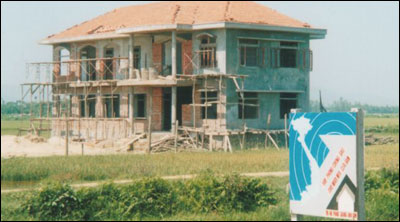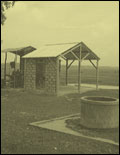| home |
Risk
Other Approaches to Damage & Preparedness

Mobilising complementary approaches to preparedness and prevention
In the face of repeated disasters in Viet Nam, Government strategy for prevention and preparation has tended to focus on strengthening and developing larger infrastructure, securing land and sea based productive capacity and protecting dykes and riverbanks *1. When a disaster happens the government and the international community have all been active in both responding to the emergency situation. As a result, death tolls have steadily declined, and in the aftermath of a disaster, food relief and help in tidying up and reestablishing services and facilities is quick. But for damage to homes, the government assists where it can by handing out some materials to those who have lost their homes, and a family may get a small reconstruction grant, but that is not certain. Following typhoons and floods in 1999 that destroyed 10 000 houses and damaged 470 000 in central Viet Nam, the prime minister decreed exceptionally * that 1 million VN Dongs (+/- 80 Euros) be given to each person whose house has been destroyed to help reconstruction. Again in 2001 after Typhoon Ling Ling, the province of Binh Dinh provided VND 3 million to each family that had lost its house*4.

But safe reconstruction is costly and the level of support, if received, is inadequate in proportion to the real recovery cost to the family. Faced repeatedly with major losses, families and local communities have themselves to take on most of the burden of domestic rebuilding, with only exceptional support* . The cost of rebuilding is considerable, and many families (a) have to borrow large sums in order to recover, and (b) often find themselves living in houses that are at best no stronger than before, and at worst, considerably weaker.
Learning from this, organisations such as the International Federation of the Red Cross and the Vietnam Red Cross have in the past helped by giving "core" safe houses, but this approach is often inflexible and does not take account of the reality that many people in Viet Nam have made progress in building their own home suited to their family needs and customs. It is in this latter environment and in complement to national strategies that DWF’s promotes a strategy that encourages people to incorporate disaster resistant construction details into both existing buildings and new construction. This preventive action mobilises local resources and capacity, respects local custom and needs, and safeguards the investment that the family has already made in their home and that local authorities have made in small local public facilities.
DWF’s efforts have not gone unrewarded. After Cyclone N° 6 Xangsang in 2006, the Thua Thie Hué Provincial People’s Committee issued an instruction to the Districts and the population to adopt the ten key principles of safe construction.
This is reproduced in translation below
| PEOPLE’S COMMITTEE OF THUA THIEN HUE PROVINCE Director Board of Disaster Militigation and Rescue |
SOCIALIST REPUBLIC OF VIETNAM Independence- Freedom-Happiness *** |
No.: 150 / CV-PCLB Hue, 17 October 2006.
To: People’s Committee of Districts and Hue City.
From the results of the damage survey of the storm N°6 effecting buildings such as accommodation, offices, and so on around our province, besides the strength of the typhoon, another reason was that construction work by private as well as organizations did not have insurance technical standard to the inhabited areas that are often hit by disasters.
To restrict the losses for the next period, we propose to the locals, the departments, the designers and the owners to pay attention to following points:
- Implement 10 rules for planning construction houses in the disaster areas that experienced for years (attached detail document).
- In case we have not reinforced and strengthened the houses and other construction sites yet, one needs to insist on the structure of the roof with beam to make into one stable structure.
- Apply the traditional methods by using the available material to prevent roof flying such as banana trees, bamboo ties, sand bags, etc.,
Do not use stones, bricks; cutting the weak trees around the sites.
- Thua Thien Hue Stock Consultant Construction Company should share the experiences of DW to do the anti-storm houses and have the popular instruction about the anti-storm houses model to the community to apply house reinforcement knowledge.
5. The locals are requested to take the lead to reduce the bad effects of the storm N°.6 with the reinforcing to housing and other public work as well.
CC:
|
For the Chairperson of Board |
*1.See, for example, the Central Provinces Initiative for
Natural Disaster Mitigation in Central Viet Nam, Second National Strategy
and Action Plan for Disaster Mitigation and Management in Viet Nam, March
2002.
*2 A recent Prime Ministerial Decree (August 2002) offers flood exposed families
to be relocated in a safer place in the Mekong Delta, with a credit system
for land (10 millions VN Dongs) and for a house (8 millions VN Dongs).
*3 Central
Committee on Flood and Typhoon Control “Official report on the damage
and response to flood and typhoons in the south-central and central highland
provinces of Viet Nam.” Hanoi, November 1999.
*4 Viet Nam News Agency, Nov 12 2001.